Industry is ‘third world banana republic stuff’ alleges local ecological forester
|
|
This is by no means a new battle: in fact, Tasmanian industrial foresters and environmentalists have been fighting over the issue of clearcutting the island’s forests for decades. The battle—some would probably prefer ‘war’—is over nothing less than the future of Tasmania.
Some Tasmanians see the rich forests that surround them in terms of income, dollars and cents; they see money literally growing on trees, or more appropriately growing on monoculture plantations and government owned native forests. They see the wilderness of Tasmania as an exploitative resource.
Others see a wild and unique place that is vital for the preservation of biodiversity, river health, and mitigating climate change. They see a place that has an intrinsic value beyond ecosystem services or natural resource extraction: a place of beauty and spirituality. In their eyes it is an ecosystem that should remain largely untouched.
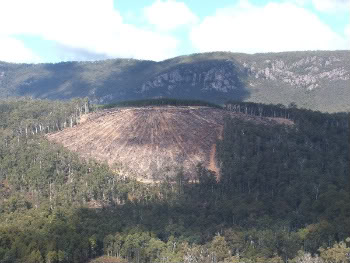 Clear-cut in Tasmania. Photo by: Pete Godfrey. |
Finally others, probably a minority, believe it could be both—that given the right managers forests could be harvested in a carefully selected way and still preserve the biodiversity, water, air, and unique beauty of the island.
Frank Strie, ecological forester and president of Timber Workers for Forests, is in the last category. While he is profoundly upset by the system of forestry employed in Tasmania—what he describes as “wanton destruction”—he does believe in the ability to use forests as resources, while at same time maintaining a healthy vibrant diverse forest.
German born and educated, Strie moved to Tasmania in 1987 to work as a Training Development Officer for the forestry industry. “I resigned from my position after just 18 month in disgust,” he says, adding that “I know this industry very well and I am doing [everything] in my power to expose the mismanagement and corruption.”
Allegations abound
The issue is so hot that protests have continued steadily over the past decade. Thousands have taken part in marches against a new proposed pulp mill, while more intrepid activists have established camps in logging areas or practice sit-ins in trees. The camps have been raided by police several times with arrests following. Allegations fly on both sides. Activists claim that police have used violence against them; the forestry industry accuses activists of laying potentially deadly booby traps. Clearly, communication has broken down.
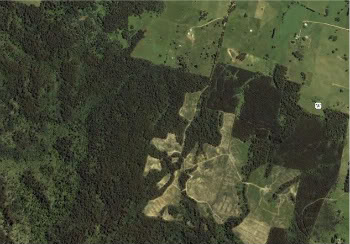 Clear-cut at Caveside near Chudleigh in Tasmania as seen from Google Earth. Image courtesy of Pete Godfrey. |
One wonders if the polarization of the two sides would have developed had not Forestry Tasmanian (the government corporation in charge of forestry) and Gunns Limited (the powerful corporation heading up industrial forestry on the island) been increasingly seen to be engaged in what critics consider poor stewardship and corruption at the cost of Tasmania’s wildlife and people.
“The decades of mismanagement and deliberate conversion of mixed age, mixed species forests to simplistic tree crops has massive impact on social, environmental and in fact commercial impact on other industries and employment in the forest / timber industry,” Frank Strie says.
According to Strie this mismanagement has cost Tasmanian ecosystems greatly: for one thing, he says, the loss of diverse forests has impacted rainfall in a region where many believe climate change has already led to longer and more intense droughts.
“Today [June 1st] we learned from the weather bureau that the North East third of Tasmania only had between 10 percent to 20 percent of the monthly rainfall. However as we know from other regions of massive climate change events, when the heavy rain returns it will fall on a reduced landscape surface area, thus the runoff is rapid and will erode more and more land, valuable soil and nutrients get transferred from the upper catchments downstream and they ultimately end in the estuaries of the island and the sea,” Strie explains. In addition, he adds that there is a “major direct impact on the hydrology of streams and rivers.”
Forestry Tasmania immediately counters against such accusations. “We harvest around 1 percent of state forest for wood products each year, and all harvested areas are regrown,” Meaghan Newson of Forestry Tasmania says. “Native forests are regrown without the use of pesticides or chemical fertilizers.”
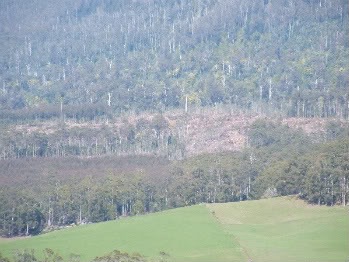 Plantation at Chudleigh. Photo by: Pete Godfrey. |
She goes on to point out that “Tasmania is one of the most protected places on earth. No less than 45 per cent of Tasmania’s forests are protected within the World Heritage Area, national parks, forest reserves and other reserves. One million hectares, or 79 per cent of all old growth forest, is protected in reserves in Tasmania. This level of conservation exceeds international benchmarks.”
In Tasmania the term ‘old growth forest’ means that it “is equal to / like ‘virgin forest’, meaning untouched by white man. Mature mixed native forest is a better term for old growth-like forest that may have or may not had any disturbance / tree felling since white settlement,” says Strie.
It is clear that Forestry Tasmania and critics like Strie have a fundamental difference in how they view Tasmania’s forests. For Strie, the clear felling of forests—where the entire area is logged in one go—is an archaic form of forestry that should no longer be viable.
“The present kind of forestry / logging / woodchip export industry was established over a period of some 36 years, at first to ‘clean up the rubbish on the forest floor’ but ultimately to get a maximum commercial short-term gain out of the rich forests and catchments, but […] this is now for fewer and fewer people and companies,” Strie says.
Certainly, Tasmania’s clearcutting brings in money and creates jobs—but what does this mix of mature native forests and plantations eventually go on to produce?
A report called ‘Oldgrowth for Export’ by The Wilderness Society and Still Wild Still Threatened found that 86 percent of Tasmania’s extracted wood ends up as woodchips for export. Most of the woodchips make their way to Asia. At least 20 percent go to Tasmania’s biggest customer, Japan. These woodchips are then made into paper.
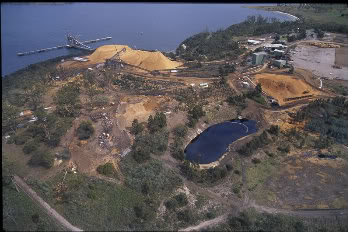 Gunns Ltd. woodchip mill in Tasmania. Photo courtesy of the Wilderness Society. |
In 2007 the trade suffered further embarrassment when a report from RAN (Rainforest Action Network) showed that the Japanese corporation Nippon Paper had misled its consumers about its source for paper. While the company claimed that it was not sourcing from old growth (or mature mixed) forests, the investigation found that in fact old growth forests in Tasmania had gone to make Nippon’s paper.
“The Australian government has publicly stated that at least 2,500 hectares of old growth forests are logged annually in Tasmania,” Senator Bob Brown, leader of the Australian Green Party, told RAN. “Any claims that Tasmania’s old growth forests are protected are patently untrue.”
Less than 5 percent of Tasmania’s wood becomes solid wood products. According to ‘Oldgrowth for Export’ 78 percent of the original tall-eucalypt forests have already been cleared or are currently open to logging.
For critics the fact that Tasmania’s forests are being ground down to wood chips for paper appears to add salt to the wound, making it even more difficult for the sides to see eye-to-eye.
Did you say napalm?
Napalm is a gelled flammable liquid, developed in the US during World War II and employed heavily in the Vietnam War. One doesn’t usually connect napalm with forestry, but allegedly Tasmania’s forestry industry is using napalm (or something similar) to firebomb areas that have been clear-felled for plantations.
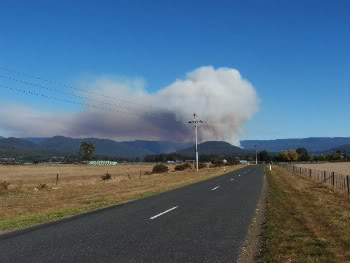 Burning of forests by helicopter near Meander Dam. Photo by: Pete Godfrey. |
They have been “doing it for decades,” alleges Strie, “and it turns our normally crystal clear air and sky into terrible, global pollution. The day temperature […] of logging burn-offs by helicopter and drip torch is simply a criminal act to all on this planet.”
Newson told mongabay.com otherwise: “Forestry Tasmania does not use napalm to clear forests.” However, the government-owned company does say that they employ controlled burning after logging. “Eucalypt forests are fire-adapted and regenerate through the use of fire. In wet eucalypt forests, an ash bed must be created through planned regeneration burning to provide the young trees with light and nutrients to grow,” Newson explains.
Despite their claim that they do not use napalm—perhaps it is simple matter of ‘nomenclature’, since the term ‘napalm’ relates both to a specific type of gelled flammable substance or any general gelled flammable substance—the process of firebombing is a matter of course in Tasmania’s forestry industry.
“Logging occurs, napalm is dropped and instantly huge mushrooms clouds of smoke, greenhouse gases are released to the atmosphere. Many people are surprised that a practice such as this occurs in a developed country like Australia,” Paul Oosting explains.
Government and corporate cozying
Oosting, a Pulp Mill Campaigner for The Wilderness Society, Tasmania, is involved with the most recent battle between environmentalists and the forestry industry. This fight is over Gunns’ proposal for a new pulp mill in the Tamar Valley in northern Tasmania.
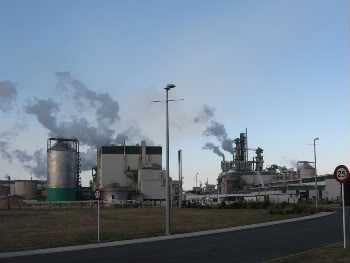 A pulp mill in New Zealand. Photo courtesy of The Wilderness Society. |
“[The proposed mill] is a major Australian environmental issue due to the far reaching impacts the project would have on jobs, climate, biodiversity and communities,” says Oosting. “Gunns […] made statements that they would abide by the independent assessment of the pulp mill but they later pulled out of the independent assessment and since then there has been NO assessment of the pulp mills impact on native forests, wildlife or climate change.”
One of the criticisms that have occurred again and again—including regarding the proposed mill in Tamar Valley—is the perceived coziness between the forestry industry and the government, both local and national.
“Gunns has received a lot of support from the State Government,” Oosting explains, using the mill as an example. “When it looked like the independent assessment of the pulp mill would not approve Gunns project they pulled out of the assessment. The government then rushed legislation through parliament and approved the mill without an independent assessment or public input. It was then revealed that Gunns own lawyers were involved with the government in drafting legislation to approve the pulp mill. Gunns also has an ex-Premier of Tasmania on its Board.”
Strie sees the relationship between Gunns and the government as inherently corrupt.
“Gunns and Forestry Tasmania and other large companies working hand in hand with the Forestry Union (CFMEU) and the Tasmanian Forest Industries Association (FIAT) are so powerful that they have for the last two decades converted the Liberal and Labor [parties] into lame supporters of the wanton destruction. It is greedy, grubby and third world banana republic stuff!” he says. “The collusion of the Tasmanian Government and the Forest Industry mafia has established with great effect and public expense a process that divides the community and exploits the opportunities.”
A question of carbon
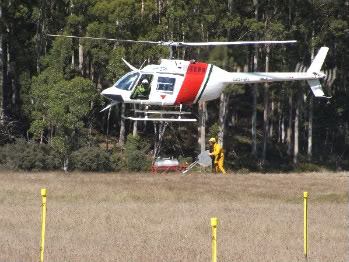 Helicopter taking off near Meander Dam. Photo by: Pete Godfrey. |
While unwilling to comment on its relationship to Gunns, Forestry Tasmania claims it has successfully managed a rare thing in the developed world: a climate-friendly industry, one that is a carbon sink rather than a carbon emitter.
“Research carried out by independent consultants MBAC Consulting of Melbourne for Forestry Tasmania estimates that between now and 2050, Tasmania’s state forest will absorb 31 million tons more atmospheric carbon than it will release, making Tasmania’s state forests a net sink of carbon,” Newson says. “That represents an average annual increase of 720,000 tons, or 24 per cent of the total of the state’s carbon emissions. The Australian Government Department of Climate Change acknowledges that forestry is the only carbon positive sector of the Australian economy.”
A recent study showed that forests in places like Tasmania and Australia actually store more carbon than tropical forests, with the world’s most carbon-rich forests in Victoria, Australia.
“Unlike substitutes such as steel, aluminum, concrete and coal, wood products provide many carbon benefits,” Newson adds.
But one could argue that since 86 percent of the wood ends up as woodchips for paper, the large majority of Tasmanian wood is not in fact replacing carbon intensive industries at this time.
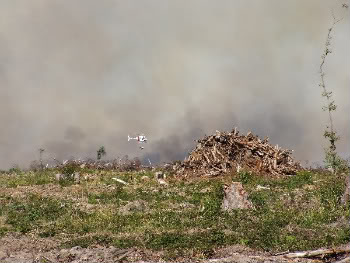 Critics contend that the burning is harmful to the climate. Burning by air at Meander Dam. Photo by: Pete Godfrey. |
Strie does not for a minute believe the argument that Forestry Tasmania and Gunns Limited are helping the climate.
“They even claim to be the only industry that is doing good things for the global climate/carbon balance!” he says. “Their slippery spin doctors have the funding to run glossy promotions on TV, radio and in print, here in Australia and in Japan and China, they have propaganda machine established that steamrolls any opposition or alternative attempt.”
In order for critics to believe the forestry industries claims regarding carbon emissions, the first thing that would have to change would be the firebombing of forests.
“The use of napalm to start fires to burn areas after they have been logged is archaic and a major driver of climate change,” Oosting says. “This practice releases greenhouse gases that have been sequestered and stored in these natural ecosystems over hundreds of years.”
A new economic reality
Those who crave change in Tasmania’s relationship to its forests, see glimmers of it in the global economic fallout.
Strie believes that the economic crisis, as well as changes in society and resource availability, will inevitably make forestry in Tasmania, as it is currently managed, no long viable. Change is coming.
“The industry will rapidly run into ruin now, as the international commercial world is changing and the global climate is rapidly changing and the transport fuel and hydrocarbon costs go up. The peak oil issue […] will soon end the 36 years of greed driven binge,” Strie says. “[Gunns’] years as a greedy, arrogant and selfish company executives will (have to) come to an end. They will learn it the hard way, just like so many other high flyers around the world that crashed down over the last few months, weeks and days.”
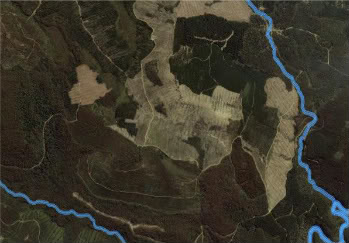 Clear cuts south of New Norfolk as seen through Google Earth. Image courtesy of Pete Godfrey. |
Oosting agrees that the forestry industry is hurting due to less demand for paper—and he sees the current downturn as a chance to make significant changes. “We are pushing to have this downturn taken as a positive opportunity to reform the industry out of native forest destruction into plantations and carbon storage.”
However, Newson contends that the industry is doing fine.
“Forward orders from our customers are promising. There has recently been an upturn in demand for high quality saw logs, which has eliminated the saw log stockpile to the point where there is now a shortage of good quality logs,” she says, adding that, “it may be expected that the economic value of timber to Tasmania will continue to grow as more people recognize the value of wood in reducing carbon emissions.”
The Tasmanian tragedy
Regardless of whichever side you’re on, the conflict has produced its share of tragedies. A notable one is Roelf Roos. Like Strie, Roos was born and raised in Germany. After experiencing childhood during World War II in Berlin, Roos moved to Australia at the age of 21 and then Tasmania. According to those who knew him, Roos loved the Tasmanian woods.
“Roelf’s regular contributions to a variety of newspapers and the Tasmanian Times website indicated how profoundly disturbed he was by the broad scale clearfelling of the beautiful native forests (and poisoning of wildlife) which became a beloved part of his life,” wrote Dr Frank Nicklason, spokesman for Doctors for Forests, in a letter to the Tasmanian Times. Nickalson goes on to write that Roos was a proponent of sustainable forestry, but “he was implacably opposed to the conversion of biodiverse forests to highly chemical dependent, genetically modified, monoculture pulpwood crops.” Such plantations were appearing all around Roos’ home.
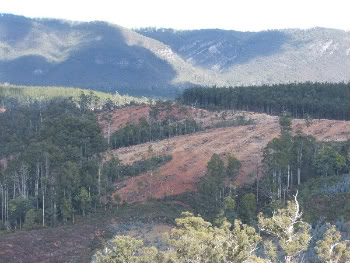 More clear cuts. Photo by Pete Godfrey. |
“The death and destruction involved in current Tasmanian forestry must surely have evoked dreadful visions of Roos’s childhood. In despair and feeling powerless Roelf Roos took his own life on Remembrance Day 2004.” He was 71.
Nicklason concludes his letter: “the mental health consequences for people who experience these feelings of hopelessness and oppression as a result of corporate domination and carelessness are yet to be fully recognized.”
Certainly, Roos’ life and death are testament to the importance of the natural world, beyond utility, profit, and even the services important for humans—such as clean water, air, biodiversity—which healthy ecosystems provide. It is this intangible quality of forests and other ecosystems that nature-lovers have a hard time communicating to those who don’t experience it. It is an experience for which language falls short.
Toward the future…
Given the complexity of the issues, the long history of emotional clashes, and the deep divisions it has created, one finds is difficult enough to comprehend the present situation in Tasmania, let alone the future.
“Forestry Tasmania has invested considerable funds and expertise in the development of alternatives to clearfelling in old growth forests. Research has shown that the aggregated retention system of harvesting retains habitat for a wide range of birds, mammals, insects and understory plants. This system of harvesting also retains old growth trees with hollows,” Newson says, pointing toward a possible future for Tasmanian forestry.
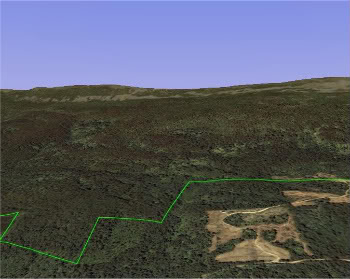 Clear cuts at South Mole Creek as seen through Google Earth. Image courtesy of Pete Godfrey. |
Oosting, representing the environmental movement in this case argues for protection over exploitation.
“Tasmania’s native forests are recognized as one of the biggest stores of greenhouse gases on the planet. These forests have an incredible ability to store greenhouse gases in vegetation, soil and wood debris,” he says. “These ‘carbon banks’ as they are called are unique in that not only do they trap greenhouse gases protecting our climate but they are home to unique wildlife such as the worlds largest freshwater crustacean and the giant Wedge tail eagle. These wild forests are also water catchments for many communities and are of course an inspirational and spiritual place for people to visit and enjoy. The global community needs to support the urgent protection of not only Tasmania’s irreplaceable native forests but forests everywhere – our future and our climate depend on it!”
Strie, who has been criticized by both the forestry industry and hardcore environmentalists on the island, has new ideas for how best to approach forestry in Tasmania.
“Now in mid 2009, we have wasted valuable years, one and a half decade in fact, we wasted irreplaceable forests and ecosystems since 1994, all this without having ever established the will, energy or process to have a real alternative to the present situation,” he laments, but adds that there is hope for the future.
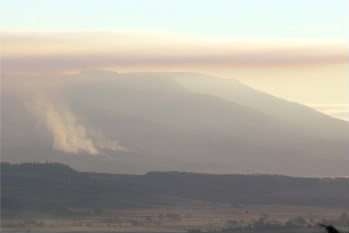 Smoke rises over the Tasmanian horizon at Chudleigh. Photo by Pete Godfrey. |
“We need to build on the living examples around the globe, the positive examples of community based and often privately initiated close to nature management.” He points to a non profit program in Ireland called Pro Silvia as well as current policies in Scandinavia and Central Europe.
But what does this look like?
“In short: working with nature! Keeping the chainsaws out of the virgin forests, (untouched by white man), and by identifying within the collaboration of community, industry, science and industry a plan of restoration action and industry that puts a holistic, total quality objective on things. A triple win process that has a seashore to mountain approach.” Still he says “it will take more than one century to restore (if ever possible) the natural functions of healthy, rich and diverse forests.”
To the frustration of those who would like to see change in Tasmania, the power remains largely in the hands of the forestry industry, led by Gunns, and the government. So far both the liberal establishment and the corporations have not relented in their philosophy of ‘business as usual’.
Clearly, though, the critics are not going anywhere either, nor are they willing to be silent (as evidenced by the robust responses I received for this article). Although they have different visions for Tasmania’s forests, critics are currently united in their opposition to current practices. For frustrated foresters like Strie, NGO managers like Oosting, and hardcore activists who spend their nights in trees and camps, the war rages on.
Gunns Limited did not return requests for comment.
Related articles
Climate pact must halt deforestation and industrial logging of old-growth forests, exclude carbon credits for forest conservation, say activists

(06/09/2009) A global framework on climate change must immediately halt deforestation and industrial logging of the world’s old-growth forests, while protecting the rights of forest communities and indigenous groups, said a broad coalition of activist groups in a consensus statement issued today at U.N. climate talks in Bonn Germany. The statement said the successor treaty to the Kyoto Protocol should not include mechanisms that allow industrialized countries to “offset” their emissions by purchasing carbon credits from reducing deforestation in developing countries, a position that puts the coalition at odds with larger environmental groups who say a market-based approach with tradable credits is the only way to generate enough money fund forest protection on a global scale.
Economic crisis hurts forestry sector, sustainability initiatives
(03/16/2009) The global economic crisis has slowed demand for timber products and may undermine efforts to improve the environmental performance of forestry, reports the U.N. Food and Agriculture Organization (FAO) in its biannual “State of the World’s Forests 2009”, released today.
Japanese paper firms contribute to destruction of old-growth forests in Tasmania
(02/15/2009) A new report released by Australian conservation groups The Wilderness Society and Still Wild, Still Threatened shows that despite claims to the contrary, Japanese paper manufacturers are the purchasers of wood chips derived from the destruction of Tasmania’s old growth forests.
Monoculture tree plantations are “green deserts” not forests, say activists
(09/19/2008) A number of environmental and social organizations have declared September 21st: International Day against Monoculture Tree Plantations to highlight the social upheaval and environmental degradation ૼ including impacts on global biodiversity and climate change — wrought by industrial plantations.
Old growth forests are giant carbon sinks, helping offset emissions
(09/11/2008) Old growth forests are important carbon sinks that help global warming, reports a study published in the journal Nature. The results run counter to claims by the forestry industry that old growth forests are carbon neutral or even net emitters of carbon dioxide.
Google Earth now reveals damage caused by the paper industry
(08/12/2008) A new web site uses Google Maps to provide information on the pulp and paper industry.
Reduced impact logging can save 160 m tons of carbon emissions per year
(08/06/2008) Improving inefficient logging practices could significantly reduce greenhouse gas emissions from forest degradation, argues a new study published in the open-access journal PLoS.
Australia’s forests contain three times the expected carbon
(08/06/2008) Australia’s natural eucalypt forests store three times the carbon conventionally believed, reports a new study by scientists at the Australian National University.
Forestry will play a critical role in slowing global warming
(06/12/2008) While reducing deforestation and forest degradation would pay great dividends in the fight against global climate change by eliminating up to a fifth of greenhouse gas emissions, other mechanisms can also enhance the capacity of forests to sequester carbon from the atmosphere, show researchers writing in this week’s issue of the journal Science.
Forests face governance challenges
(06/12/2008) Governments “own” about 86 percent of the word’s forests, but recent changes in forest management structure means they effectively control far less than they did just a generation ago. As such, the fate of forests is increasingly determined by concesssionary agreements with extractive industries and the whims of market demand for commodities produced on forest lands. Climate change and rapid economic growth are poised to further complicate effective management of forest areas.
Tasmania agrees to logging moratorium
(05/30/2007) Forestry Tasmania, the forest service of Tasmania, has signed an agreement with environmental activists to cease logging activities in the Upper Florentine Valley of the island. The moratorium will last through federal elections this in October..